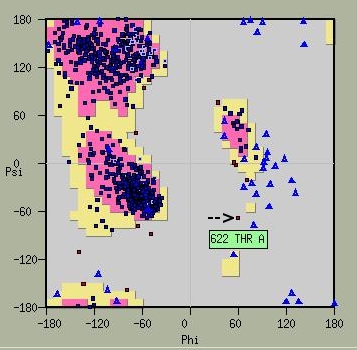User:Karl E. Zahn/Sandbox RB69 1/palm-domain
From Proteopedia
|
The two-metal ion mechanism employed during the DNA pol catalytic cycle relies on coordination of divalent cations by conserved aspartate motifs in the [1][2]. The palm domain of RB69 DNA pol (residues 383-468, 573-729) contains such (LDFASLYPSI and DTDS) that are particular to family B DNA pols. Interestingly, the residue T622 in this sequence must obtain a high energy conformation in order to correctly orient the D621 and D623. This property is evident in Ramachandran plots of RB69 DNA pol where T622 is an obvious out-layer. L411 and D412 complete the coordination sphere of metal ion B.
A common strategy for crystallizing DNA polymerases in complex with both DNA and an incoming nucleoside triphosphate utilizes a dideoxy-terminated primer strand in the DNA molecule. Since the 3'-OH is absent, the reaction can not proceed following binding and alignment of the substrates. However, since the 3'-OH is required to complete contacts to the coordination sphere of metal ion A, complexes with chain terminated primers often illustrate perturbation or absence of this ion[3]. Metal B is absent in the structure 2OZS.
References
- ↑ Steitz TA, Steitz JA. A general two-metal-ion mechanism for catalytic RNA. Proc Natl Acad Sci U S A. 1993 Jul 15;90(14):6498-502. PMID:8341661
- ↑ Doublie S, Tabor S, Long AM, Richardson CC, Ellenberger T. Crystal structure of a bacteriophage T7 DNA replication complex at 2.2 A resolution. Nature. 1998 Jan 15;391(6664):251-8. PMID:9440688 doi:http://dx.doi.org/10.1038/34593
- ↑ Batra VK, Beard WA, Shock DD, Krahn JM, Pedersen LC, Wilson SH. Magnesium-induced assembly of a complete DNA polymerase catalytic complex. Structure. 2006 Apr;14(4):757-66. PMID:16615916 doi:http://dx.doi.org/10.1016/j.str.2006.01.011

